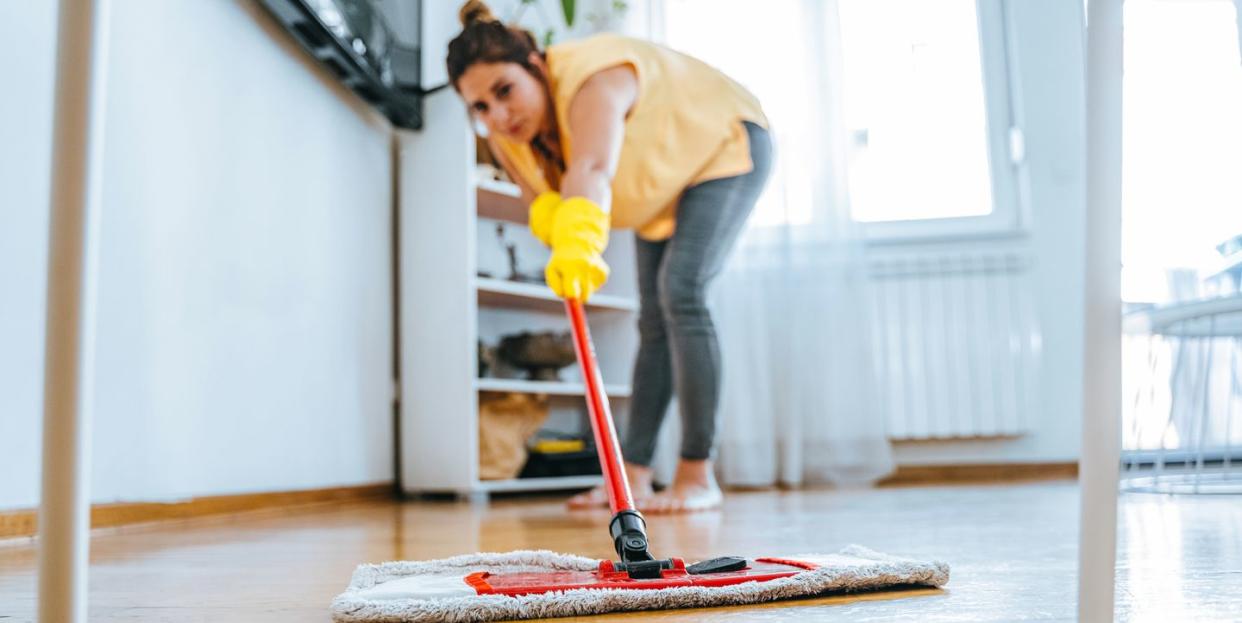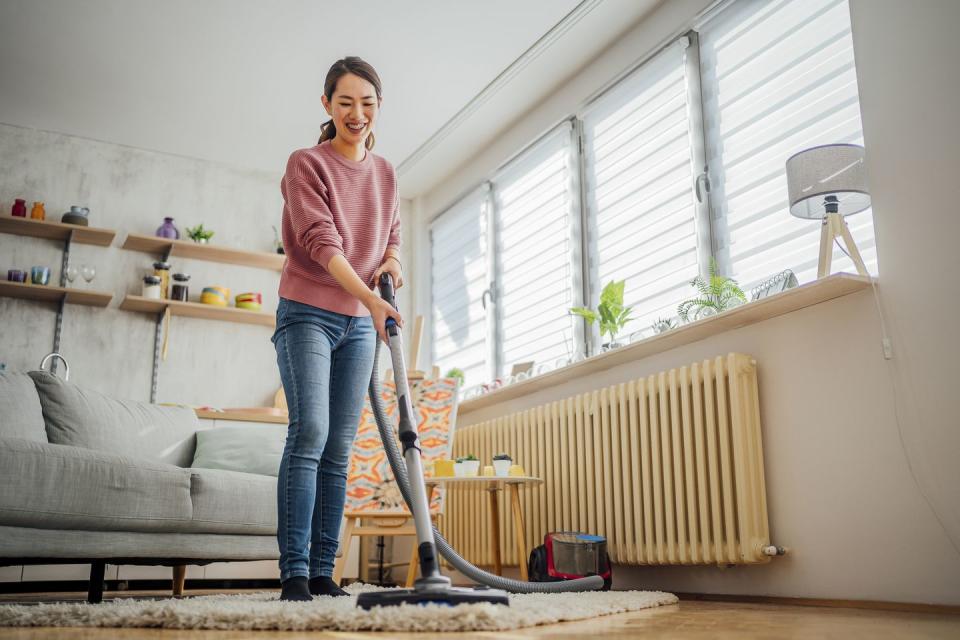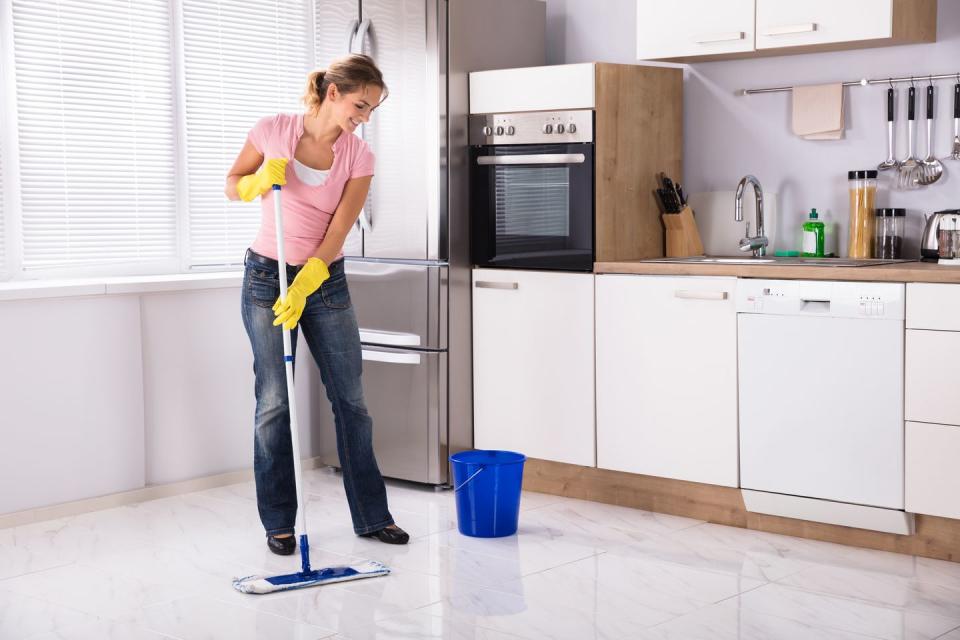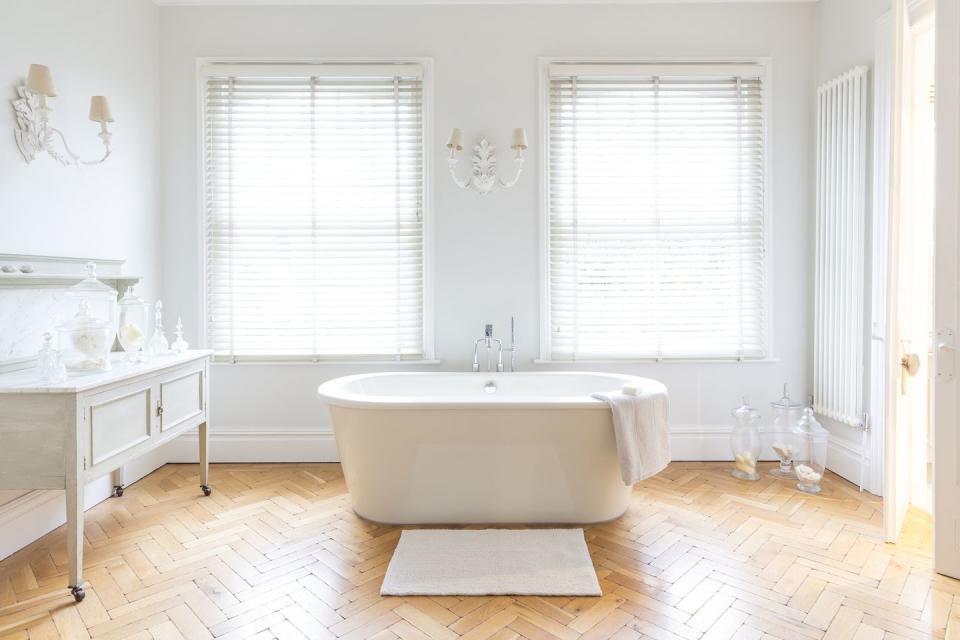How to keep your floors sparkling clean

Cleaning the floors is no one’s favourite chore, but it is important. Otherwise dust, debris and stains can build up. Before you know it, hair is embedded in your carpets and muddy paw prints have found their way across your hard floors; it’s only natural with everyday footfall.
Depending on whether you’re dealing with wood, carpet, vinyl, linoleum or stone, each floor type requires a different treatment. This is important because abrasive products and methods can damage the surface, so care must be taken. To help you out, we’ve pulled together a comprehensive guide on cleaning your floors, so you know exactly what to do.
How do I keep my floors clean for longer?
It may not feel efficient, but keeping on top of dust, dirt and grime day to day is a better approach than letting it build up and having to spend longer doing a big clean. One way you can do this is by using doormats at entrances and taking your shoes off when you enter the house.
Top floor care tips
9 PLACES YOU'RE FORGETTING TO VACUUM

How often should I clean my floors?
This really depends on the floor type, its location and the amount of footfall it receives. Generally speaking, you should clean your hard floors every few weeks to keep them sparkling. But, if you’re dealing with an unsealed or delicate flooring, such as terracotta tiles or cork, follow the frequency and directions as recommended by your manufacturer.
You should only mop (if mopping is allowed) after you’ve vacuumed so any debris is removed first. If not, you’re just scrubbing the dirt around your floors, which could potentially scratch it. It’s also better to deal with your floors last when it comes to your chores, so any dust you’ve removed after cleaning gets picked up at the same time.
Obviously, if there are any sudden spills or stains, or your pet decides to come running in with fresh mud on their paws, you’ll need to address your floors immediately, especially on porous surfaces such as marble.
While carpet needs vacuuming one to two times a week, you don’t need to deep-clean it so often. Cleaning your carpet twice a year is sufficient to refresh it, but more often may be necessary if you have pets, small children or allergies.
There are smaller carpet spot cleaners available, such as Vax’s SpotWash Spot Cleaner. These can come in handy when you’re dealing with a sudden spill.
How to clean laminate floors
Vacuum, dust or wipe with a lightly dampened mop – never use soap-based detergents, as they can leave a dull film on the floor, and avoid over-wetting. Don’t use wax polish either, as this will make the floor slippery.
To remove marks and stains, use a dilute solution of water and vinegar. Don't be tempted to use abrasive cleaning kit, such as nylon scouring pads or steel wool, as they can scratch laminate.
Stubborn marks, such as shoe polish, can be removed with a nail polish remover containing acetone, or other mild solvents. Trusty old WD-40 is also effective.
To protect the floor, put felt pads underneath furniture legs and drip trays under plant pots.
GHI Tip: Vacuum or sweep all types of hard floors regularly to prevent the surface being scratched by grit, and remove shoes at the front door.

How to clean ceramic and quarry tiles
Thankfully, these need minimal maintenance! Sweep and wash with a mild detergent solution, before rinsing with clean water. Never use wax polish – the tiles will become slippery.
You could also try a steam cleaner. They’re a quick and effective option for cleaning sealed floors and tiles, and they only need water to get the job done.
How to clean terracotta tiles
For the first year after installation, terracotta tiles mature. Most floor suppliers stock a special cleaner, sealant and polish to use on terracotta tiles, so be sure you use the products recommended on yours.
How to clean cork
Wipe factory-sealed cork tiles with a damp mop, using a washing-up liquid solution. For an extra layer of protection, especially in high-traffic areas such as the bathroom and kitchen, apply an acrylic or polyurethane sealant.
Never over-wet cork floors, and take care not to damage the seal or protective coatings by dragging appliances or furniture across them.
GHI Tip: Scuff marks on your skirting boards? Squirt them with WD-40 and wipe them away with a soft cloth.
How to clean vinyl
Sweep with a soft brush or vacuum, then wipe with a damp mop, using a mild detergent. Rinse thoroughly after wiping. To remove scuff marks, use a cloth dipped in neat washing-up liquid or white spirit, then rinse off.

How to clean stone
Stone is susceptible to staining, so it should always be protected with a resin sealant. To clean sealed stone, vacuum it thoroughly, before mopping with a mild detergent solution.
To remove grease or oil, use a proprietary spot-treatment stain remover for stone.
How to clean wooden floors
Sealed floors need only to be swept and damp-mopped. Don't use too much water or the wood could swell and split.
Unsealed and waxed floors should be swept regularly and occasionally re-polished. Use wax sparingly, as any excess will leave a tacky residue and attract dirt, then buff well. Should worn patches appear on the surface, apply a non-slip floor polish.
GHI Tip: Never varnish a waxed floor – it won’t dry!
On a waxed floor, polish and dirt builds up over time. The only way to clean it is to remove the wax and start again. Use a cloth moistened with white spirit. Let it soak in, and as the wax and dirt begin to dissolve, wipe it away with crumpled newspaper. Scrub obstinate parts by hand, or with abrasive pads on a floor polisher.
Once all of the polish has been removed, damp-mop with clean water. Leave it to dry completely before applying new polish, one small section at a time.
For protecting your wooden or parquet flooring, we recommend Dr Beckmann Hardwood & Parquet Floor Cleaner. It nourished our boards and brought slightly faded ones back to life.

How to clean linoleum
Sweep or vacuum to remove grit and dust. Clean with a mop or cloth dampened with a floor cleaner or detergent solution. Use water sparingly. Rinse after washing.
Stubborn marks can be removed by rubbing lightly with a dampened fine nylon pad.
How to clean carpet
If you own a carpet cleaning machine, this is the best way to clean your floor. If not, you can still do a good job without one.
Start by spot-treating any stains using a product such as Dr Beckmann Carpet Stain Remover. Simply use it according to the manufacturer’s instructions but be sure to test on an inconspicuous area first. It’s always best to target stains quickly; the longer you leave before removing a stain, the harder it will be.
Next, you’ll want to tackle the carpet with your vacuum. Once you’ve been over it once, use your vacuum accessories to clean hard-to-reach areas. Use the crevice tool to vacuum the edges of your carpet and under radiators — this will help to prevent black lines forming around the skirting board. If your carpet is particularly thick, use the turbo brush (or power brush) to collect stubborn dirt and pet hairs.
GHI Tip: Remove any annoying indents and impression marks left by furniture by rubbing an ice cube over the affected area.
You Might Also Like


